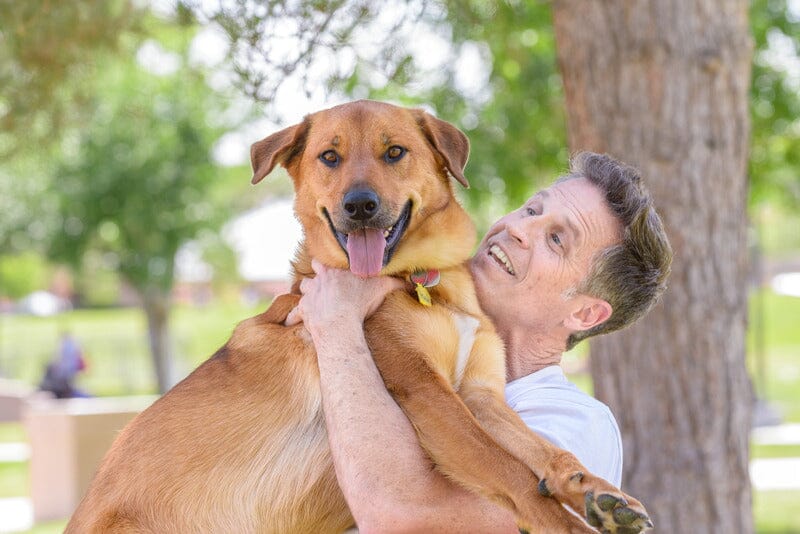HAVE YOU EVER HEARD ABOUT THE LEGEND OF THE OLDEST DOG THAT EVER LIVED?
Until recently, Bluey, the Australian Cattle dog who lived to a ripe old age of 29 years dog held the Guinness Book of World Records title as the oldest dog, but now that record has been broken by Bobi.
Bobi is a purebred Rafeiro do Alentejo, a Portuguese dog breed that normally live to about 12 to 14 years; but Bobi is defying those odds.
Bobi is over 30 years old and is still living happily with his family; showing us that it is possible for a dog to defy their genetic dispositions and live longer, happier, and healthier lives.
According to the American Kennel Club, the lifespan of dogs depends on size and smaller dogs do tend to live longer than larger breeds.
The generally accepted lifespan for dogs stacks up as follows (on average):
- Small dogs (Chihuahuas, Yorkies) - 12 to 17+ years
- Medium to large dogs (Beagles, Collies) - 9 to 13 years
- Giant dogs (Great Danes, Mastiffs) - 6 to 8 years
Don't you wish your best friend can live forever?
Have you dreamed of moving through different life stages with your dog right by your side? Regardless of size, with proper care any dog, even large breed dogs, can defy the odds.
With February being Pet Dental Health Month, as well as the month we celebrate National Walk Your Dog Day and Love Your Pet Day, what better month to start taking better care of and lengthen your pal's life?
The four (4) essential health changes outlined in our guide below will help you give your dog a chance at enjoying a longer life.
Consider them as your weekly challenges for the month of February or adopt them as your new year resolutions as a pet parent.
Best of luck!
WEEK 1: ADD MORE FRESH WHOLE FOODS TO YOUR DOG'S DIET
Ensuring your dog has a diet of fresh whole foods is critical to adding years to your dog's life. Bobi's pet parent believed that his access to unprocessed and unseasoned human food contributes to his long lifespan.
Fresh whole foods such as fruits and vegetables, dairy and meat, offer our pets digestible, nutrient-rich food that can have a profoundly positive effect on a pet's overall health; and, it also can be a great aid in avoiding, treating, and remedying many health issues.
As not all fruits and vegetables that are good for us are also good for our canine companions, make sure to check what human foods are safe for dogs to eat and which you should avoid; also which ones you should put on your "add to your dog's diet" list. Items such as orange, mango, Brussel sprouts, and others that you may not have thought of, provide many nutrients for pets.
While it may be expensive and inconvenient to create tasty homemade dog food from fresh ingredients regularly, you can always add whole foods to supplement your dog's favorite kibble.
According to the Integrative Veterinary Care Hospital the consumption of a non-toxic vegetable at least three times a week resulted in a 70 – 90% risk reduction in the development of cell carcinoma in Scottish terriers. Now isn't that worth adding a few more vegetables to your dog's diet?
Their research also shows that this type of diet improves a dog's brainpower, making them more alert (and probably more playful). The other important factor is how many treats you are giving your dog. Even if you feed them the best food possible, knowing how many treats is too many to give your dog , or which are the wrong kind of treats can help your dog avoid obesity and many other problems down the road.
And if your pup is a picky eater and is just not getting enough nutrients in their diet, then look into a good multi-vitamin or supplement that can help fill that nutritional gap. However, if they are getting all their nutrients but have problems absorbing them, then consider a probiotic or a homeopathic remedy to address the gut issue.
Your Week 1 Healthy Pet Challenge:
Add one of the following safe whole foods to your dog's diet within week one:
-
Eggs:
You can scramble it or serve it hard-boiled; eggs are good for dogs! They're packed with essential amino acids, good fats, fat-soluble vitamins, and minerals. You’ll want to limit eggs to just a few times a week as too much can lead to your pup packing on extra unhealthy pounds. For added safety, consult your vet to find out how many eggs your dog can eat per week; this is a good idea to ensure you do everything in your power to help them maintain a healthy weight required for a longer life. If you have concerns about whether it is safe for your dog to consume raw eggs, feel free to read Pet Helpful’s perspective on it here.
-
Fruits and Veggies:
Can dogs eat apples, bananas, tomatoes or avocados? - You better check!
As we mentioned above, apples, watermelon, carrots, leafy greens, sweet potatoes, and even peas can be nutritionally beneficial for your dog. However, be sure to remove all pits and seeds before feeding these to your pet.
On the other hand, some fruits and vegetables, such as raisins and avocados are not safe for dogs. It may be a great source of nutrients, but before giving your dog any people food make sure to check if the fruit or vegetable is okay for dogs to eat as some fruits and vegetables can be toxic to your dog.

-
Lean Meats:
Wondering if pork, turkey and other meats are an option for your dog? Fido must have a balanced diet. Try giving your pet some lean ground beef, white fish, or even chicken breast to boost their ability to form new skin cells, build muscle tissue, and even grow glossy fur.
Some pet parents swear by feeding their dogs raw while others may be apprehensive about giving their pet raw lean meats. Experts have largely said it's okay; however, there are some precautions that must be taken to ensure optimal safety for your pet. Pet MD gives some great insight on this in their article on raw food diets for dogs.
-
Probiotics or Prebiotics?
Vets agree that many health problems stem from the gut. A healthy gut microbiome (the bacteria in your dog's gut) is crucial for digestion and helping your dog to get nutrients from the food they eat. In order to support your dog's healthy gut you need both probiotics and prebiotics.
At this point, you may be wondering, what's the difference?" Simply put, probiotics “seed” good bacteria into your dog’s gut and prebiotics “feed” the good bacteria that is already in your dog’s gut microbiome." Both prebiotics and probiotics come in supplement form but there are also certain foods that naturally contain these. Adding as little as a spoonful of yogurt at mealtime can provide digestive benefits. PetMD.com gives the green light for feeding your pup probiotics like yogurt or kefir, but pay attention to what's on the label; choose a low-fat option that has little sugar, artificial flavoring.
Be sure there is no Xylitol; it's toxic to dogs. Because probiotics may not be enough, look for foods that naturally contain pre-biotics, such as: certain mushrooms, chicory root or garlic to provide this necessary boost to your dog's gut microbiome.Always make sure to check with your pet's veterinarian to ensure your pup has a balanced diet.
WEEK 2: COMMIT TO DAILY WALKING/EXERCISE
Prolong your dog's life by sticking to a daily walking/exercise routine (and not just for a pee break). Leonel Costa, Bobi's owner says that Bobi spends most of his time outside roaming their farmland. When another owner of the unofficial oldest dog in the world was interviewed, he mentioned that the Kelpie farm dog possibly walked/ran 9km a day.
Now, the recommendation isn't for your pup to over-exert themselves. The amount of exercise required for each dog is dependent on their age and breed. It can vary from between 30 minutes to 2 hours a day. Keep reading to find out more about the requirement for your dog’s breed.
It’s important to keep in mind that exercise will result in lower stress, increased endorphins, and a balanced mood while also helping your pal maintain a healthy weight, muscle mass, and an efficient cardiovascular system.
Your Week 2 Dog Walking Challenge:
Walking shoes and doggies booties on! It's time to go for a walk—every day!
The PDSA shares a guide that tells you how long you should walk your dog daily. If you've got a larger breed like a German Shepherd, you may be thinking, "Wow that's a whole lot!" However, you can make it easier for you and your pal by doing a one-hour walk session in the morning and a fun play session in the evening.
It doesn't matter how you meet the time goals daily; focus on meeting the minimum exercise time limit for your furry friend's breed.

For arthritic dogs who experience severe pain while walking, PetMD.com has a great guide for how to get these dogs to exercise safely. Even if your dog is just starting to slow down, limps occasionally following a walk it may be a good idea to check your dog for signs of joint problems before exercising them too much.
And when it's the winter season, ensure your dog has their waterproof booties on to protect their paws. But even when the weather is nasty, there is no reason not to exercise your dog; there are plenty of things you can do inside to let your energetic pup exercise at home.
WEEK 3: GIVE THEM EXTRA LOVE!
It's not just about their physical well-being; stress and anxiety can cause problems for pets as much as for people. Your furry friend's good mental health is also important for longer life.
A daily snuggle is great for your dog's happiness.
Between the stresses of work, daily life responsibilities, and an ever-growing list of to-dos, cuddling with your pet sometimes fall to the wayside. Not only is it a nice thing to do but it's essential in increasing the lifespan of your dog.
Here are TWO reasons why:
1. Bonding is a biological need
Cuddling is a natural craving for your pet; after all, dogs are pack animals. Not giving your pet the daily love they require can result in anxiety, withdrawal, depression, and even severe eating challenges. These negative impacts will shorten their lifespans.
2. You'll notice any signs of ill-health
Cuddling also helps you to become more attuned to your pet's health. Daily love sessions will enable you to spot when something is wrong right away. While stroking your pet, you may notice a lump or bump, an unpleasant smell, or a pattern of avoidance and low moods.
Your pet can't tell you when something is wrong but these signs and symptoms will wave the red flag for you to seek medical attention immediately.
Your Week 3 Love Challenge:
There is no one-size-fits-all approach to how a cuddle session should go. What's most important is that you spend a 15-30 minute uninterrupted period with your dog every day. Dog breeds like the Sharpei, Scottish Terrier, and Fox hounds are not fans of cuddling. As such, you'll have to take it easy with them.
Listen to their body language and don't push it if they're not into it. Walking, playing with toys, or simply spending quality time nearby all qualify as a love session. Your pet will be happier and healthier!
WEEK #4: TAKE YOUR PET FOR A CHECK-UP!
You are already aware that your dog needs regular check-ups to stay healthy. Thorough physical exams will allow your pet to get the care required should any health challenge appear. If you've met the following recommendations, then you're off the hook for Week 4's Challenge (just a little):
For puppies:
It's important for young puppies to get regular checkups to ensure they are growing and gaining weight as they should. They will also need some shots to make sure they are properly immunized before they go out into the world and start socializing with other dogs.
For Adult Dogs: Ages 1 to 7 years
Your mature dog will require one yearly check-up. A head-to-tail physical will be done. Always ask for blood work to be done.

For Senior Dogs: 7 – 10 years and beyond:
Senior dogs require an extra expert eye on them. Vets recommend twice-yearly check-ups for older pets.
Your Week 4 Dog Health Challenge:
Make it your duty to take your Fido to the vet for a check-up.
In addition to the overall check that your vet does, ensure your vet checks your dog's teeth for signs of periodontal disease. Plaque, tartar and doggy bad breath can impact more than just your pup's teeth, they're a major problem that negatively impacts the possibility of a longer life.
Given this is the grand finale in our guide, we've added a bonus challenge!
PREVENTION IS BETTER THAN THE CURE BONUS: Brush their Teeth Daily!
Poor oral health can affect more than your dog’s teeth; if the bacteria spreads into their body it can lead to heart, lung, liver and kidney problems. Help your pet avoid loosing their teeth or fatal gum diseases by brushing their teeth twice daily.
Using a dental wash specially for dogs and brushing three times a week is the minimum recommendation to help remove plaque and prevent tartar accumulation. If your pup has stomatitis mouth ulcers or inflammation and won't let you brush their teeth because of tooth or mouth pain, the BestLife4Pets Oral Health for Dogs natural remedy can help them feel better.
Don't neglect their dental health; their life depends on it.
Having your pet with you for several years will take some extra effort. However, once you make these weekly challenges a part of your dog care routine, it will become easier. The idea is to keep each challenge in motion for a lifetime.
Are you up to the challenge?
Your pup will love you for it and you'll have them around - healthy and happy for many years to come!



